Saturday, February 21, 2009
 All my blogs on the Why Do I Blog? theme have featured a photograph of my granddaughter Rebecca who is now 11. This time around I have also placed a picture of her sister Lauren who is 6. I posted my first blog, with no picture on January 20, 2006. On February 24, 2007 I wrote a blog that I projected while speaking at Northern Voice 2007, a blogging conference held at UBC. On February 23, 2008 I also spoke at Northern Voice 2008 and again projected a blog that day. This year I will not be attending Northern Voice 2009. The conference sold out much too early and I was left out. The pleasure of chatting with like-minded souls will not come my way. I have decided to take advantage of the opportunity that this loss provides me to reflect on that initial question that I made and tried to answer back on February 24, 2007 - Why do I blog? On that date the hot topic was Twitter. It took a couple of years for Twitter to make the mainstream. Last year cloud computing was the item of discussion in all corners of UBC's Forestry Sciences Centre where Northern Voice is held every year. In many respects this amateur blogger who does not understand the difference between Apache and Java, or what they are, knew that I was getting inside information before the hoi polloi (οἱ πολλοί) did. But as I feel saddened by not seeing my friends this coming weekend I realize why I blog more than ever. The reasons I had before are still in effect. I want to write about my family and my granddaughters. While Rebecca (note her picture here) still looms large I have found a delightful interest in her sister Lauren. Lauren looks at me straight in the eye. I love her for it.  This blog is a safety valve for the frustrations I feel as a soon-to-be former magazine photographer and writer. I took pictures for magazines for many years and and when the market began to downturn I discovered that writing and taking pictures extended my worth just a bit more. I was paid less for the photographs and less for the writing. Adding both cheques made my earnings a bit more substantial. But that is rapidly ending when you consider that culture and the arts are now buried in our Vancouver Sun in the food section. The Vancouver Sun discourages freelance work, too. It was not too long ago that the travel editor for the Sun, after running a story I wrote about traveling with Rebecca to Argentina (the editor ran it front page with lots of pictures) told me that she didn't want to hear from me again as she had her little stable of writers. Before I started this blog, my frustration in not being able to take pictures or to write was pushing me into a dangerous zone of bitterness. Bitterness and self-employment can be a devastating cocktail. The blog dissipated it, steam was released and I now feel much better for it. It is not important that I keep a count (I don't) on who reads or if anybody (as long as some of my family and friends do that's all that matters) reads this blog. Not having a comments section certainly diminishes the blog's chance for more popularity. But I have seen how comments have corroded away initial optimism of such good BC-based online news magazines like The Tyee. I would not want these ranters to contribute to my blog. The blog gives me the opportunity to post pictures (I take many of them exclusively thinking of the blog) that magazines would not want to run with copy that might be too personal for mainstream magazines. In short I write about anything I want to write about and place pictures to accompany copy. It fulfills my desire to tell a story which I believe has to be a trait that is hard-wired in all of us. In my 35 years in Vancouver I have amassed a huge archive. My eldest daughter Ale began for me some years ago the necessary and useful task of putting some order into it. I am not sure that my archive has any value except to my own self-worth but one has to soldier on in the same way that a friend of mine soldiers one with a novel knowing that finding a publisher in today's climate will be very tough. One has to make the motions if one is to get up from bed every day. This blog has helped me put an order into that archive. Sometimes I look through my files randomly for a blog idea. Sometimes I conjure it in bed in the middle of the night and rush down to look for the picture in my files. Right now Rosemary and I are putting our family pictures into files by year and in some cases in themes such as Christmas or self-portrait. While the writing jobs are all but gone I find that I can write much more quickly today than I did three years ago. It was writer James Ellroy who told me, "Sometimes I open my manuscript in the morning and change a comma. And that's all I do for that day. But that is writing. And you have to write every day if you want to be a writer. Changing that comma is writing." He was right. Most important, I blog because I value content. I value long, well written articles by professional journalists who work for hard copy dailies like the NY Times, the online Guardian and the Argentine La Nación. It is hard for me to find this content in Vancouver. The comments section of the Globe & Mail is as scary as any other. The fact that anybody can give an opinion does not necessarily make that opinion a good one. Imagine a book conference that featured all you ever wanted to know about the making of paper for the books. A conference that would tell you about pagination and the cutting of pages and the stretching of cloth for cloth-bound books. If you were interested in the physical properties of books you might find the conference to your liking. If you were looking for lectures on the actual content of those books you might be a bit on the disappointed side. Similarly my only complaint for the yearly Northern Voice Blogging Conference is that there is too much emphasis on the mechanics of blogging and the computer language that supports the structure of a blog. The conference is a bit short on blog content. Next year I will make sure to sign up early so as to not be disappointed. I also hope that this year and next year they bring back a bit more as to why we blog and what we blog about. I first heard of the concept of citizen journalism when Paul Sullivan (I worked for him when he edited West Magazine) talked about a site he had started Orato.com. The site coincided with the opening of Robert Pickton's trial and Sullivan hired former prostitutes and working prostitutes to cover it. I thought the experiment was interesting because I thought I respected the meaning of that serious sounding word citizen. The word being used these days does not sound so nice. Citizen journalism is now touted as amateur journalism. I am not suggesting that my blog has content. I am suggesting that my blog is not a rehash of, "I read the other day that the city is going to enlarge left-turn lanes. And that is one terrible idea..." Just go to any Vancouver blog aggregator to see such mindless amateur journalist regurgitation of our daily news. You can look into food blogs that are ample example of why food photography is a difficult art. Digital photographs of stews or beans are always going to look like a digested and extruded dog's breakfast. While my deprecation on the value of amateur journalism could be contested few would argue that amateur food photography has a long way to go before it becomes an attractive medium. 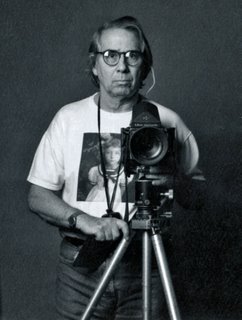 At best magazines have always been a symbiotic relationship between copy and pictures, be they photographs or illustrations. At one time when I was assigned to take pictures for a magazine the editor would send me the copy to read. This would help me in being able to secure a photograph that would go hand in hand with what was written. Now I rarely get sent copy. More often than not I photograph people before they have been interviewed. And that interview can many time be on the phone and now, with increasing frquency, online. While I cannot vouch for the quality of what I write I can vouch that some of my photographs do have value and particularly now in an age when cameras have built-in telephones. "We read not only because we cannot know enough people, but because friendship is so vulnerable, so likely to diminish or disappear, overcome by space,time, imperfect sympathies, and all the sorrows of familial and passional life."I have inserted that quote from Harold Bloom's How to Read and Why many times in these blogs. When I first read it, it hit home. There are a few former friends of mine with whom I have consciously broken off after many years of knowing each other. In some cases circumstances of work produced this distancing. I wrote about that hereBut read Bloom's sad apology for fading friendship while replacing read with blog. It makes as much sense. As my circle of friends fades, disappears, dies off, etc I could always resort to social networks. I could make new friends with Facebook or participate in forums (These degenerate into insults very quickly!) in photography web sites. I could tell people (and all those who would "follow" me with bated breath) what I am doing right now with Twitter. But I will not. I cannot abide with the idea of making friends with people I have never met and then exchange pleasantries with them on the net. These social networks, with their false sense of intimacy, remind me of the glory holes of the pre AIDS era. Glory holes first became popular in San Francisco. Gay men would go to these establishments and enter compartments that sported a smallish hole on the wall. The man would insert his male member and someone on the other end would indulge him with intimacies of a paradoxically anonymous kind. In the mid 50s women would call us on the public phones that we had on each floor of our Catholic boarding school, St. Ed's in Austin Texas. They knew we were all boys, locked up for a week and probably also knew that the only woman on campus was an older cook. They would sweet talk us for hours. We would try to get an address, a return phone number and perhaps a date. But it was to no avail. They would hang up with the promise that they would call again. How were we to know that we were experiencing (without the use of a credit card, and at the time the only one was Diners Club) that yet-to-be-developed phenomenon that is phone sex? 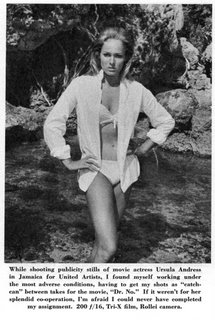 As I read my New York Times (the one made from forests) in bed in the morning, every morning, not having to see if anybody has left me any texting messages in my cell phone (It can but I don't let it.), I understand that I am a living anachronism with a memory for Plymouth Furies, Studebaker Golden Hawks and Packard Clippers. I know that the hottest Bond woman was Ursula Andress (photograph by Bunny Yeager), ample proof as to why the Swiss invented perpetual wrist movements for their chronometers. I know that I am an anachronism when I am wowed by the body of Esther Williams in Million Dollar Mermaid . Whom could I possibly call besides that other living (and much younger) anochronism friend of mine, John Lekich, who knows you never wear a button-down shirt with a bow tie? Who else can I tell that all my life I hated Esther Williams films with all that stupid (but now wonderful) synchronized swimming and that silly and perpetual smile of hers and that late in life (this past Tuesday) I have suddenly discovered she had a body to kill for? As my world shrinks, blog I must.
Friday, February 20, 2009

During the Easter Vacation a student trip to Washington, D.C. was planned and carried through to a more than successful student activity under the direction of Brother Vincent de Paul and with some guidance from representatives of the Greyhound Bus Line a “Capitol to Capitol” tour was arranged with stop-overs and extended stays in such places as New Orleans, Chattanooga, Asheville, Roanoke and finally a four day vacation in Washington, D.C. A personal welcome in Washington by such people as Miss Grace Tully, Representative Thornberry, Senator Yarborough, Mr. Perry, and Senator Kilday from San Antonio, made the stay in Washington Memorable. Areas of the Eastern states, hitherto unknown to Texans and other foreign students revealed natural wondrous views as seen on these pages. Conducted tours through all the important government buildings and treasure houses of art and science plus seeing historical monuments made the trip an educational as well as a vocational venture. Holy Thursday Mass at St Ignatius Church and a Good Friday morning spent at the Franciscan Monastery allowed for devotional exercises which were climaxed by Easter Sunday Mass in Nashville, Tennessee. The names of the boys who made the trip are listed below:
Douglas Williamson, Henry Altmiller, David Burratti, Lawrence Ballard, Francisco Calderoni, John Clark, Thomas Canales, Cesar Diaz, Joe Davis, Richard Ferris, Robert Franzetti, Ivan Gaiennie, Victor Giancintti, John Fischer, Mike Graham, Jorge Hayward, Richard Isaac, John King, Emile Lapeyrouse, Pat Lynch, Kenneth Manion, Fernando Martinez, Walter Miller, Otto Ramsey, Briand Rene, Dan Sherrod, Vincent Taylor, Thomas Huddleston, Clarence Olson, Ted Dugey, Ed Maurer, Jose Jimenes.
Edwardian, 1959

The mind works in unexpected ways. Yesterday I watched Pygmalion with Rosemary's cat Toby on my lap. This is the original Pygmalion (they don't sing!) directed by Anthony Asquith and Leslie Howard. It stars Leslie Howard and Wendy Hiller with
Wilfrid Lawson almost stealing the show as Alfred Doolittle.
Here are some irrelevant facts about the original stage production in English of Pygmalion on April 11, 1914. It seems the play was premiered in German in Vienna on October 16, 1913. The London-staged play was directed by Bernard Shaw himself and it featured Mrs Patrick Campbell as Eliza and Sir Herbert Beerbohm Tree as Henry Higgins.
1. Shaw's play shocked Edwardian audiences with Eliza's swearing in the line "Not bloody likely!". Campbell was considered to have risked her successful career by speaking the line.
2. A story goes that Shaw, as part of an ongoing feud with Winston Churchill, sent Churchill tickets to the opening night of Pygmalion, with an attached note saying that "I have included two tickets so that you may bring a friend, if you have any." Churchill sent a reply: "I regret to say that I am unable to attend that night; I would like tickets to the second performance, if there is one."
3. Thanks to Pygmalion, George Bernard Shaw was the first person to have been awarded both a Nobel Prize (Literature - 1925) and an Academy Award (Pygmalion - 1939).
What is the relevance of the film Pygmalion to my trip to Washington D.C. in 1958? The tenuous link (not in the least for me) is my mother. In 1958 as a more-or-less single mother sending me to an expensive boarding school while earning the probably not too generous salary of a school teacher must have been hard-pressed to find money to send me on this trip when I asked her if I could go.
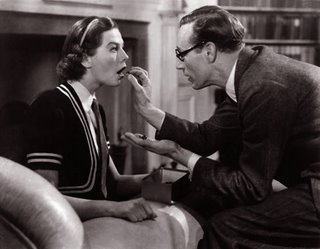
It is probably one of the most frequent tragedies of our existence that we don't appreciate what we have or get until we don't have it or until the person who gave it to us is long gone. While watching Leslie Howard (my mother's favourite actor, besides Joseph Cotten) I realized how good Howard was and how absolutely terrific Wendy Hiller was, so believable in ways that Audrey Hepburn wasn't. I had seen the film many years ago with my mother but I was too young to appreciate Bernard Shaw's wit uttered by the actors of Pygmalion. I was much too young to understand my mother's skill, sacrifice, taste and how they all influenced in making me a much better person than I surely was or could have been without her influence. I was not quite picked up from the gutter - and changed into a glamorous society butterfly! But close enough. The film hammered into my head how lucky I have been in having had the mother I had. The film gave me another indication on how that school in Texas had helped to transform me into the marginally better person I am today.
That trip to Washington DC in our very own rented Greyhound Scenicruiser made me fall in love with the United States, with its South and with Washington D.C. The American Civil War, that had so fascinated me all those years, became more immediate since we toured some of the battle grounds. In Washington D.C. a visit to the Willard Hotel (read paragraph below) became a wonderful sleeper virus that led me to take Rosemary and Rebecca, so many years later to the very same hotel and many of those other places that Brother Vincent de Paul and Brother Dunstan took us. It was in Washington where I bought my first real camera (in a pawnshop) an Agfa Silette. I quicky outgrew it and my subsequent purchase of a Pentacon-F pushed me finally into what I do today.
The high point then (I wasn't that dense or stupid) and more so even now is that my mother had allerted her sister Dolly Humphrey that I was going to Washington D.C. My Aunt Dolly's husband, Bill had a sister, Helen Humphrey who was a highfalutin lawyer in DC. Aunt Helen picked me up after getting a green light after being under the critical scrutiny of Brother Vincent de Paul (below, right), and took me to a session of the US Supreme Court. After that she took me for tea to the Willard. I remember her probing intelligence and her quiet and easy charm.
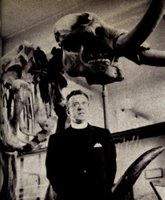
There is one more interesting connection with Pygmalion. It is with a book that has been in my possession since 1977. I like to re-read it every few years. It is Computer Power and Human Reason - From Judgment To Calculation by Joseph Weizenbaum. On page 3 Weizenbaum writes:
 I chose the name ELIZA (the author's bold) for the language analysis program because like the Eliza of Pygmalion fame, it could be taught to "speak" increasingly well. Because conversations must be about something, that is, because they must take place within some context, the program was constructed in a two-tier arrangement, the first tier consisting of the language analyzer and the second of a script.
I chose the name ELIZA (the author's bold) for the language analysis program because like the Eliza of Pygmalion fame, it could be taught to "speak" increasingly well. Because conversations must be about something, that is, because they must take place within some context, the program was constructed in a two-tier arrangement, the first tier consisting of the language analyzer and the second of a script.
This book was one of the first books to look into the possibility of artificial intelligence. I can only wonder now if Professor Henry Higgins would ever be able, not only to make a computer speak increasingly well, but also to think. Thanks to my mother and those brothers of the Holy Cross at St. Ed's I don't do such a bad job of thinking and speaking. I don't think that Professor Henry Higgins himself could possibly discern remaining traces of that Texan accent that I surely must have had at one time.
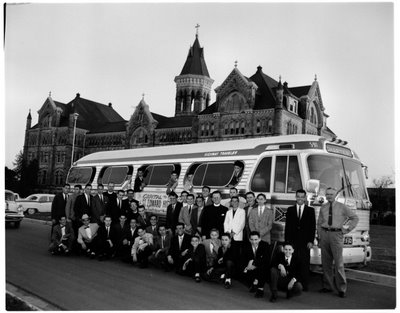
Addendum
It seems that my memory of the events and my imagination led me to the idea that our Greyhound bus was a Scenicruiser. I was wrong and this picture pleasantly sets the record straight. I received a communication from John King Class of 1961 who also went to Washington DC. He wrote:
I found this picture surfing an Austin history website at NTU. Recognize anyone in there?
John
The Snowdrop
Thursday, February 19, 2009
 Galanthus nivalis Galanthus nivalis, the common snowdrop, has reliably early white drop like flowers with a green dot or spot. Several garden cultivars exist, some with larger flowers than the species, some with double flowers, as well as some later flowering varieties. Snowdrops are one of the earliest spring bulbs often flowering in early January. At a height of 4 - 8 inches (10-20cm) they shows off best in clumps, naturalized under deciduous trees or shrubs. You can see in the second scan of my garden snowdrops the detail that from afar looks like a green spot. After having lived in Mexico for so many years I cannot get used to this lovely plant that needs winter cold in order to faithfully come back every year. If I were to associate this beautiful little pure white flower with someone I know in Vancouver I would assert that Ballet BC's Simone Orlando is as close as anybody gets to being as beautiful as a snowdrop. 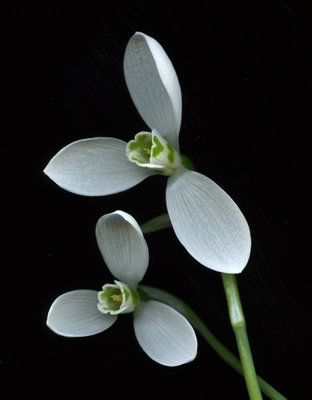 THE SNOWDROP AND THE CRITIC By Thomas Paine To the Editor of the Pennsylvania Magazine, 1775. Sir— I have given your very modest “Snow Drop” what, I think, Shakespeare calls “a local habitation and a name;” that is, I have made a poet of him, and have sent him to take possession of a page in your next Magazine: here he comes, disputing with a critic about the propriety of a prologue. Enter Critic and SnowDrop. CRITIC. Prologues to magazines!—the man is mad, No magazine a prologue ever had; But let us hear what new and mighty things Your wonder working magic fancy brings. SNOW DROP. Bit by the muse in an unlucky hour, I’ve left myself at home, and turn’d a flower, And thus disguised came forth to tell my tale, A plain white Snow Drop gathered from the vale: I come to sing that summer is at hand, The summer time of wit you’ll understand; And that this garden of our Magazine Will soon exhibit such a pleasing scene, That even critics shall admire the show If their good grace will give us time to grow; Beneath the surface of the parent earth We’ve various seeds just struggling into birth; Plants, fruits, and flowers, and all the smiling race, That can the orchard or the garden grace; Our numbers, Sir, so fast and endless are, That when in full complexion we appear, Each eye, each hand, shall pluck what suits its taste, And every palate shall enjoy a feast; The Rose and Lily shall address the fair, And whisper sweetly out, “My dears, take care”; With sterling worth, the Plant of Sense shall rise, And teach the curious to philosophize; The keen eyed wit shall claim the Scented Briar, And sober cits the Solid Grain admire; While generous Juices sparkling from the Vine, Shall warm the audience until they cry—divine! And when the scenes of one gay month are o’er, Shall clap their hands, and shout—encore, encore! CRITIC. All this is mighty fine! but prithee, when The frost returns, how fight you then your men? SNOW DROP. I’ll tell you, Sir: we’ll garnish out the scenes With stately rows of hardy Evergreens, Trees that will bear the frost, and deck their tops With everlasting flowers, like diamond drops; We’ll draw, and paint, and carve, with so much skill, That wondering wits shall cry,—diviner still! CRITIC. Better, and better, yet! but now suppose, Some critic wight, in mighty verse or prose, Should draw his gray goose weapon, dipt in gall, And mow ye down, Plants, Flowers, Trees, and all. SNOW DROP. Why, then we’ll die like Flowers of sweet Perfume, And yield a fragrance even in the tomb! Addendum: Courtesy of my wife Rosemary. "Alex the snowdrops are not the ordinary ones. They are Galanthus elwesii : The flowers are much larger, appearing on 25cm (10in) stems, with two green marks on the inner segment of the petals and a honey fragrance. This species originates from Turkey."
Komochi Konbu & Native Royalty
Wednesday, February 18, 2009

In 1994 I had three very beautiful native Canadian "princesses" in my studio. I had been hired by a local company to promote a brand of BC Gold Komichi Konbu.
What is Komichi Konbu?
Spawn on kelp is a specialty seafood product composed of broad leaf sea kelp with a covering of herring eggs. It is also known in Japanese as komochi konbu and kazunoko konbu. Spawn on kelp has a creamy, delicate sea-like flavour and a crunchy texture. It can be used as an ingredient in a variety of dishes or on its own, either raw or cooked.
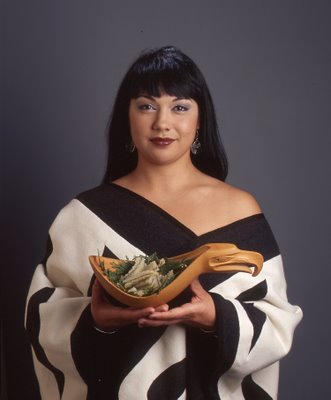
Both my eldest daughter Ale and I have been fascinated by Native Canadians. In my case my interest comes from realizing that Native Canadians look very much like the natives that populate the Americas as far as Patagonia. I have often found it frustrating that I cannot speak Spanish to Native Canadians! My daughter Ale was born in Mexico and her complexion is darkish. She considers herself very Mexican. A couple of years ago she picked up sticks and moved to Lillooet because she had the ambition of having a class made up mostly of Native Canadians. She now teaches grade 5 and her class is 65% Native Canadian. She is extremely happy in this endeavour.

For me to have these beautiful "princesses" in my studio was an unusual delight. And best of all I was also nicely paid! In order of appearance we have here Princess Miko, Princess Leslie and Princess Danielle.
Tuesday, February 17, 2009
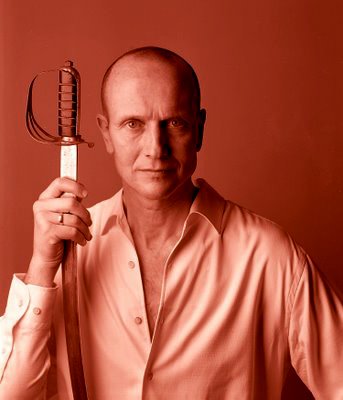 'I am a man. Nothing human is alien to me,'said the Roman, Terence. This Vlad's tale may not be 'alien', but it was still a very dark place to spend my time. Being still an actor in my heart, I always approach the characters I write as an actor would - through motivation. What events and relationships shaped their lives and affected their actions? What drove them? I sought for Vlad's motivations in the murky historical record, tried to piece together some plausible 'justification' for his actions. It was the hardest thing. And then I had an epiphany, about two thirds into the writing of the first draft - written longhand for the first time ever in an attempt to viscerally connect imagination, heart and hand - I decided not to judge him. I decided to show what he did and stop worrying why he did it. Essentially, I let him be who he was, whatever that was, to set his actions against his recorded life and in the context of the brutal place and epoch in which he lived. I would let the reader decide.
'I am a man. Nothing human is alien to me,'said the Roman, Terence. This Vlad's tale may not be 'alien', but it was still a very dark place to spend my time. Being still an actor in my heart, I always approach the characters I write as an actor would - through motivation. What events and relationships shaped their lives and affected their actions? What drove them? I sought for Vlad's motivations in the murky historical record, tried to piece together some plausible 'justification' for his actions. It was the hardest thing. And then I had an epiphany, about two thirds into the writing of the first draft - written longhand for the first time ever in an attempt to viscerally connect imagination, heart and hand - I decided not to judge him. I decided to show what he did and stop worrying why he did it. Essentially, I let him be who he was, whatever that was, to set his actions against his recorded life and in the context of the brutal place and epoch in which he lived. I would let the reader decide.
Author's Note, from Vlad - The Last Confession by C.C. Humphreys
History has not dealt Vlad Dracula, the 15th century ruler of Wallachia, a fair hand. What is most unusual of Vlad - The Last Confession (out a couple of months ago) a novel which is based on the historical events in the Wallachian ruler's life, is that the author, as he reveals in his author's note, took the unusual approach of an actor who happens to be a writer. I have read and enjoyed thoroughly three ( I could include here the memoirs and letters of Noel Coward) other actor/writers, Dirk Bogarde, David Niven and even photographed one of them, Liv Ullmann. By looking for an actor's justification, Vancouver author/actor/swordsman C.C. Humphreys has managed a measure of objectivity without affecting the exciting plot. The gory parts, an almost clinical description on the method of impalement with which Vlad kept order, and terrorized his enemies (and even kept a solid gold goblet at a public drinking fountain of his capital, without it being stolen) could be daunting for some. But this is nicely balanced with a vivid description of the art of falconry and the customs of the Turkish court of Murad Han and his son Mehmet Celebi who took Constantinople.
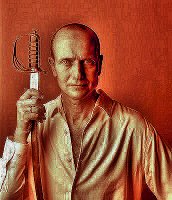
I understand this actor's justification as justification is always in the back of my head when I take a portrait. I must justify what I do or my portrait will be an empty one. If I cannot treat my subject as a human being, accept his dignity, regardless of the fact that he may be a dishonest trader or lying politician, I cannot take my picture.
Method acting can have its most positive points when you consider that Humphreys spent solitary hours in Dracula's castle to absorb the atmosphere. The book is full of this dark atmosphere and I longed to see Vlad's dark steel armour as Humphreys described it. When the reader finds out that the author is not only an actor but a swordsman, too, the battle scenes seem that much more vivid and realistic.
Perhaps the author meant to inject a bit of the events of that bloody 15th century that set up the problems of the former Yugoslavia and that area that we call the Balkans. After finishing this adventure novel, I understand a bit of what led to the partition of Yugoslavia. I would assert that Humphreys Vlad - The Last Confession read in conjunction with Robert D. Kaplan's Balkan Ghosts will serve you well if you are to understand what is happening in that part of the world.
Humphreys Vlad - The Last Confession has only partially satisfied my desire (it happens frequently) to read novels of adventure of the swashbuckling kind. Humphreys to me is similar to Cartagena, Spain born author Arturo Perez-Reverte who writes lovely but controversial essays and wonderful novels like The Spherical Chart and Club Dumas. But his fans pepper him with complaints written in pseudo 17th century Spanish asking him to get on with one more installment of his most popular novels featuring the dashing mercenary swordsman, Capitán Alatriste who reads Góngora, Cervantes and de Quevedo. At least two Alatriste novels have been translated into English.

In a similar vein I would like to communicate to the author that it is just fine to write stand alone novels like the recently deceased Michael Dibdin (we all waited for his Aurelio Zen books!) used to do but I do plead that I want more Jack Absolute, the sooner the better.
I especially need my Jack Absolute fix as Jack Absolute's competition, Matthew Hervey has just appeared in Allan Mallinson's Warrior (which I read before starting on Vlad) and Mallinson reveals that Hervey (of the 6th Light Dragoons) will not be appearing in the 11th novel for a while, "Indeed we must wait a little longer than usual: twice as long, in fact, for the eleventh book in the series will be published - Deo Volente - in two year's time, not one."
On the other hand, without revealing Vlad's ending, I can assert that even though the historical Vlad may have lost his head and had it displayed on a stake on the walls of Constantinople, things are not quite what they seem as the varcolaci (undead) can come back in more than one way. And who knows Vlad's - Last Confession might not really be his last.
Monday, February 16, 2009
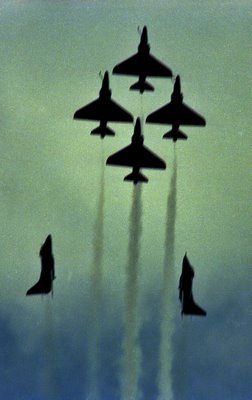
My grandmother used to always tell me, " La ignorancia es atrevida." This means that those who are ignorant are sometimes daring in what they do because they do not know any better. One August around the end of the 70s I went to the Abbotsford Air Show with my daughter Ale and my friend Paul Leisz. Both are in the picture in front of a US Navy Blue Angels A-4 Skyhawk. I attempted to photograph the Blue Angel formations and mostly failed in my enterprise as I did not know what I was doing. My most memorably stupid mistake what taking pictures of a Blue Angel flying upside down. I had no mountain or horizon reference in my picture. All you had to do was to turn the picture upside down and the airplane was flying right side up. By the time I caught up with the Blue Angels again in 1994 I sort of knew what I was doing. Look here. In 2002 I went all the way to Pensacola, Florida to the home of the Blue Angels. I wonder if any of the planes suspended from the National Naval Aviation Museum at the Pensacola Naval Air Station were any of the ones this amateur had photographed back in 1980?
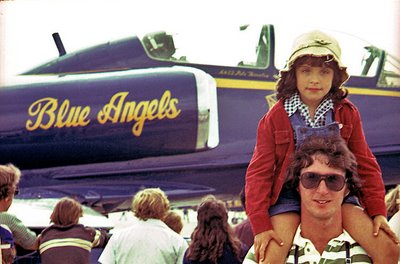 |
| Alexandra Waterhouse-Hayward & Paul Leisz |
The only person in my family that was ever interested in Airplanes was Ale. She went back with me several times through the years. She found a job working for the industry side of the show which was called Airshow Canada. She was so well-liked that she went to work for the Chilean Air Force one year in a show in Santiago.

I attempted to interest Rebecca in airplanes but her enthusiasm waned very quickly. The one time I took her I asked her which was her favourite airplane. "It's the Tomcat,"she told me. "Why?"I asked her. Her reply was most satisfactory, "Because it is the loudest."
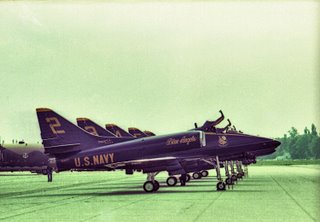
In the additional blog below I show one of the most remarkable pictures ever taken of a Skyhawk about to attack a ship. The photograph (Click on it to enlarge it. The Skyhawk is right smack in the middle.) affects me close to my heart because I have a special affection for this grand and beautiful airplane. The reason for this affection is here.
The Skyhawk & HMSS Coventry

The trap at first worked when a FAA A-4C Skyhawk coded C-304 of Grupo 4 de Caza deployed to San Julian was shot down north east of Pebble Island by a Sea Dart missile while returning from a mission to San Carlos Water. Capitán Jorge Osvaldo García successfully ejected but was not recovered from the water, (his body was washed ashore in a dinghy at Golding Island in 1983). Garcia's wingman was also shot down during the raid on San Carlos, by a Sea Cat from HMS Yarmouth (also claimed by various others in the area including a Rapier battery), but he was luckier, and ejected into captivity, in front of waiting News Crews.
They then came under attack by several waves of Argentine A-4 Skyhawks specifically sent to sink them. Despite managing to shoot down two attackers earlier in the day, on the final occasion a wave of four enemy aircraft flew so low that Coventry's targeting radar could not distinguish between them and the land and failed to lock on. Broadsword attempted to target the first pair of attackers with her Sea Wolf missile system, but her own tracking system locked down during the attack and could not be reset before the aircraft released their bombs. Of the four bombs released, one struck Broadsword's flight deck and – though it failed to explode – damaged the ship's Lynx helicopter. Though she was still unable to gain a lock on the second pair of Skyhawks, Coventry launched a Sea Dart in an attempt to distract them and turned to starboard in order to reduce her profile. On Broadsword the Sea Wolf system had been reset and had successfully acquired the attacking aircraft, but was again unable to deploy when Coventry's turn took her directly into the line of fire.
Coventry used her 4.5 inch gun and small arms against the attacking aircraft. Coventry was struck by three of the four bombs released, two exploded and she immediately began listing to port. One of the bombs had struck the computer room and the blast destroyed it and the operations room nearby, incapacitating almost all senior officers.
Within 20 minutes she had been abandoned and had completely capsized, with the loss of 19 of her crew. After the ship was struck, her crew, waiting to be rescued, sang "Always Look on the Bright Side of Life" from Monty Python's Life of Brian. She sank the next day. A memorial cross was erected on Pebble Island after the war.
From Wikipedia, the free encyclopedia
Pensacola Skyhawks
Blue Angels & the Amateur
Erik Satie, Jamie Reid, No Performance Today & A Row Of Paper Boats
Sunday, February 15, 2009

Yesterday, Saturday, Rebecca and I went to the Playhouse Theatre to experience a matinée performance of the Turning Point Ensemble (in association with Vancouver 2010 Cultural Olympiad and the SFU Contemporary Arts) of Erik Satie's Relâche. As we entered I spotted a friend. "Rebecca I want you to meet a poet, he is a member of the Canadian Communist Party." With a smile on his face Jamie Reid said," I am not a member of the Canadian Communist Party. I was a member of the Communist Party of Canada (Marxist-Leninist)." Reid handed me a copy of his latest poems. In it I found a poet who had collaborated with Satie in his Furniture Music:
homage to max jacob
I was severely mistaken in writing to a poet acquaintance that
Max Jacob took his own life.
In fact, it was only and maybe merely his afterlife he took, and he
took it deliberately as a Catholic, which he had become by
choice, not birth.
After converting to the Church of Rome, he joined the gang of
Poets and artists on Montmartre in order to sin disgracefully, so
he said.
It was not for this reason that the Gestapo later arrested him and
put him in the concentration camp where he died of lung
disease. It was because he had been born a Jew.
His conversion therefore completely failed to save his life.
I hope my poet acquaintance, who told me he feels his own
work is most like Max Jacob’s, does not come to suffer a similar
fate.
May he contrive to enjoy all sins untramelled, no matter how
considerable, without feeling any need for punishment, as did
poor Catholic Max.
May I, too, live in hope
to do the same, dear,
merciful God.
From homages by Jamie Reid, January 2009 by permission from author.
Rebecca had a chat with Christopher and Jennifer Gaze. She talked to heart surgeon Larry Burr about cross country skiing and violinist Marc Destrubé explained to Rebecca, "Erik Satie did not like anything. He only ate white foods like eggs, sugar, shredded bones, animal fat, salt, coconuts, rice, turnips, pastry, cheese (white varieties), cotton salad, and certain kinds of fish."
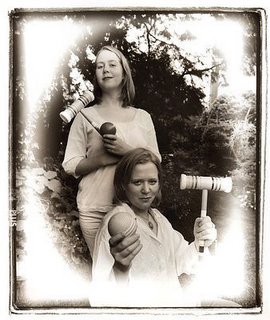
Phoebe MacRae (seen here sitting with her sister, Caitlin, standing), we were most surprised, did not play the Virgin Mary nor did she appear with a croquet mallet. She opted for singing in her beautiful soprano the Trois Mélodies de 1886.
Both Rebecca and I noticed the man, Edmond Kilpatrick. (here seen with Rebecca at Arts Umbrella) who was making the rows of paper boats on a table while cooly watching a woman, Tiffany Tregarthen (as sinuous as a snake so said Jamie Reid) dance (beautifully choreographed by Simone Orlando) as if she had not been wearing high heels.
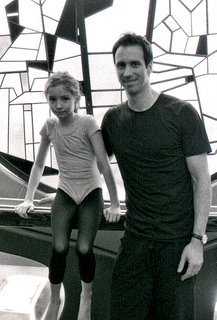
I could go on and on in the above pseudo-Dadaist/Surrealist vein. Or I could tell you what a good time Rebecca and I had at the performance. I will do neither.
My preference is to point out the strange but wonderful paradox of Vancouver that so often feels like a backwater (especially culturally) to the rest of Canada and the world.
On Friday I attended a performance of the Pacific Baroque Orchestra at St James Anglican. The leader of the group was the renowned violinist Marc Destrubé who also leads the Axelrod Quartet that is playing in Vancouver on February 27. Why was he at the 2pm matinée? Destrubé knows a rare and good thing when he sees it. The chances that anybody would ever see a live performance of Erik Satie's Relâche in one's lifetime are most unlikely. And even more so that the unlikely event would be held in Vancouver.
So the paradox is that our city offers a variety of cultural events that are first notch yet attendance is sparse in many cases while people complain that there is no culture in Vancouver, that periodicals, newspapers and magazines do not promote culture and the arts. They further add that they do not inform us or urge us to attend these events. People that I know at the CBC tell me that they have orders from above that culture and the arts are at the bottom of their priorities. People I know at the CBC tell me that no CBC affiliated radio station in the interior of BC would be interested in covering this month's tour of the Pacific Baroque Orchestra. One of the CBC spokepersons told me, "In the interior they are only interested in sports and jobs."
At yesterday's matinée of Relâche I saw no more than 5 children including my Rebecca. Just a few days ago I had been talking to art gallery owner Linda Lando and she told me, "Part of the problem lies in the school. They just don't teach them"
All I had to do to turn on Rebecca to Eric Satie was to play in our car my copy of Satie - Piano Works with Daniel Varsano and Philippe Entremont. Satie's 3 Gymnopédies are instantly charming to children. When Rebecca asked me a bit about what we had seen I told her that Satie was protesting against the idea that music, dance, culture and the arts did not have to be serious or overly long. It could be funny, entertaining, accessible and, best of all, did not have to be "understood" to be enjoyed.
 Jamie Reid reads his Homages
Jamie Reid reads his Homages
Addendum
I should also mention that I had a second reason for being at the Satie performance which is that I'm a member of the Turning Point Ensemble (and couldn't do the Satie because of the Pacific Baroque Orchestra conflict). Should also mention that the Pacific Baroque Orchestra West Van concert this afternoon was rather well-attended. I should also mention that I did a half-hour interview about the Satie program, even though I wasn't playing, for Radio Canada's Le Pont des Arts. The fact that they have a two-hour arts journal in the rush-hour time slot on their Radio One says something about different priorities in our different cultures...And this was my third lengthy interview for them in the past three months.
Marc Destrubé
|

































